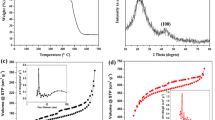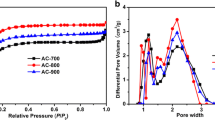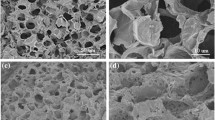Abstract
As electrode materials for supercapacitors, biomass-derived activated carbons attract much attention owing to their natural abundance and low cost. In this work, porous activated carbons are facilely synthesized from cattail wool using Ni(NO3)2·6H2O and KOH as co-etching agents. Compared with the carbons singly etched with KOH, these CWAC-x materials with hierarchical pores have much higher specific surface areas and exhibit much better capacitive performance. As for CWAC-10, the specific surface area and total pore volume are as high as 1581 m2 g−1 and 0.992 cm3 g−1, respectively. For supercapacitor applications, CWAC-10 exhibits a high specific capacitance (314 F g−1 at 1.0 A g−1 in a three-electrode system), excellent cycling stability and high energy density (37.29 Wh kg−1 at a power density of 159.98 W kg−1 in a coin-type symmetric device). The enhanced electrochemical performance can be attributed to the unique structure and the existence of O and N elements.






Similar content being viewed by others
References
Jiang LL, Sheng LZ, Long CZ, Fan ZJ (2015) Densely packed graphene nanomesh-carbon nanotube hybrid film for ultra-high volumetric performance supercapacitors. Nano Energy 11:471–480
Wang DW, Min YG, Yu YH, Peng B (2014) A general approach for fabrication of nitrogen-doped graphene sheets and its application in supercapacitors. J Colloid Interface Sci 417:270–277
Zhao CJ, Ge ZX, Zhou YA, Huang YF, Wang GF, Qian XZ (2017) Solar-assisting pyrolytically reclaimed carbon fiber and their hybrids of MnO2/RCF for supercapacitor electrodes. Carbon 114:230–241
Gao SY, Zang PY, Dang LQ, Xu H, Shi F, Liu ZH, Lei ZB (2016) Extraordinarily high-rate capability of polyaniline nanorod arrays on graphene nanomesh. J Power Sources 304:111–118
Luo JW, Zhong WB, Zou YB, Xiong CL, Yang WT (2016) Preparation of morphology-controllable polyaniline and polyaniline/graphene hydrogels for high performance binder-free supercapacitor electrodes. J Power Sources 319:73–81
Lu YH, Zhang F, Zhang TF, Leng K, Zhang L, Yang X, Ma YF, Huang Y, Zhang MJ, Chen YS (2013) Synthesis and supercapacitor performance studies of N-doped graphene materials using o-phenylenediamine as the double-N precursor. Carbon 63:508–516
Wang K, Zhao N, Lei SW, Yan R, Tian XD, Wang JZ, Song Y, Xu DF, Guo QG, Liu L (2015) Promising biomass-based activated carbons derived from willow catkins for high performance supercapacitors. Electrochim Acta 166:1–11
Li Y, Wang GL, Wei T, Fan ZJ, Yan P (2016) Nitrogen and sulfur co-doped porous carbon nanosheets derived from willow catkin for supercapacitors. Nano Energy 19:165–175
Feng HB, Hu H, Dong HW, Xiao Y, Cai YJ, Lei BF, Liu YL, Zheng MT (2016) Hierarchical structured carbon derived from bagasse wastes: a simple and efficient synthesis route and its improved electrochemical properties for high-performance supercapacitors. J Power Sources 302:164–173
Yang XQ, Li CF, Chen Y (2017) Hierarchical porous carbon with ultrahigh surface area from corn leaf for high-performance supercapacitors application. J Phys D-Appl Phys 50:055501
Lei D, Song KH, Li XD, Kim HY, Kim BS (2017) Nanostructured polyaniline/kenaf-derived 3D porous carbon materials with high cycle stability for supercapacitor electrodes. J Mater Sci 52:2158–2168. https://doi.org/10.1007/s10853-016-0504-5
An HJ, Kim NR, Song MY, Yun YS, Jin HJ (2017) Fallen-leaf-derived microporous pyropolymers for supercapacitors. J Ind Eng Chem 45:223–228
Pan ZZ, Dong LB, Lv W, Zheng DQ, Li ZJ, Luo C, Zheng C, Yang QH, Kang FY (2017) A hollow spherical carbon derived from the spray drying of corncob lignin for high rate-performance supercapacitors. Chem-Asian J 12:503–506
Su XL, Cheng MY, Fu L, Yang JH, Zheng XC, Guan XX (2017) Superior supercapacitive performance of hollow activated carbon nanomesh with hierarchical structure derived from poplar catkins. J Power Sources 362:27–38
Wang K, Song Y, Yan R, Zhao N, Tian XD, Li X, Guo QG, Liu ZJ (2017) High capacitive performance of hollow activated carbon fibers derived from willow catkins. Appl Surf Sci 394:569–577
Cheng P, Gao SY, Zang PY, Yang XF, Bai YL, Xu H, Liu ZH, Lei ZB (2015) Hierarchically porous carbon by activation of shiitake mushroom for capacitive energy storage. Carbon 93:315–324
Ren L, Zhang J, Li Y, Zhang CL (2011) Preparation and evaluation of cattail fiber-based activated carbon for 2,4-dichlorophenol and 2,4,6-trichlorophenol removal. Chem Eng J 168:553–561
Zhang J, Shi QQ, Zhang CL, Xu JT, Zhai B, Zhang B (2008) Adsorption of neutral red onto Mn-impregnated activated carbons prepared from Typha orientalis. Bioresour Technol 99:8974–8980
Liu H, Ning W, Cheng PF, Zhang J, Wang Y, Zhang CL (2013) Evaluation of animal hairs-based activated carbon for sorption of norfloxacin and acetaminophen by comparing with cattail fiber-based activated carbon. J Anal Appl Pyrol 101:156–165
Feng J, Qiao K, Pei LY, Lv JP, Xie SL (2015) Using activated carbon prepared from Typha orientalis Presl to remove phenol from aqueous solutions. Ecol Eng 84:209–217
Tao JY, Gao B, Zhang XM, Fu JJ (2016) Porous N-doped carbon microfibres derived from cattail as high-performance electrodes for supercapacitors. Int J Nanomanuf 12:225–236
Yu M, Han YY, Li J, Wang LJ (2017) CO2-activated porous carbon derived from cattail biomass for removal of malachite green dye and application as supercapacitors. Chem Eng J 317:493–502
Chen C, Yu DF, Zhao GY, Du BS, Tang W, Sun L, Sun Y, Besenbacher F, Yu M (2016) Three-dimensional scaffolding framework of porous carbon nanosheets derived from plant wastes for high-performance supercapacitors. Nano Energy 27:377–389
Ramakrishnan P, Shanmugam S (2016) Nitrogen-doped carbon nanofoam derived from amino acid chelate complex for supercapacitor applications. J Power Sources 316:60–71
Ramakrishnan P, Shanmugam S (2016) Nitrogen-doped porous multi-nano-channel nanocarbons for use in high-performance supercapacitor applications. ACS Sustain Chem Eng 4:2439–2448
Li YJ, Yu N, Yan P, Li YG, Zhou XM, Chen SL, Wang GL, Wei T, Fan ZJ (2015) Fabrication of manganese dioxide nanoplates anchoring on biomass derived cross-linked carbon nanosheets for high-performance asymmetric supercapacitors. J Power Sources 300:309–317
Zhao YQ, Lu M, Tao PY, Zhang YJ, Gong XT, Yang Z, Zhang GL, Li HL (2016) Hierarchically porous and heteroatom doped carbon derived from tobacco rods for supercapacitors. J Power Sources 307:391–400
Luan YT, Huang YQ, Wang L, Li MX, Wang RH, Jiang BJ (2016) Porous carbon@MnO2 and nitrogen-doped porous carbon from carbonized loofah sponge for asymmetric supercapacitor with high energy and power density. J Electroanal Chem 763:90–96
Lebedeva MV, Yeletsky PM, Ayupov AB, Kuznetsov AN, Yakovlev VA, Parmon VN (2015) Micro-mesoporous carbons from rice husk as active materials for supercapacitors. Mater Renew Sustain Energy 4:20
Ma GF, Yang Q, Sun KJ, Peng H, Ran FT, Zhao XL, Lei ZQ (2015) Nitrogen-doped porous carbon derived from biomass waste for high-performance supercapacitor. Bioresour Technol 197:137–142
Zhang WL, Zhao MZ, Liu RY, Wang XF, Lin HB (2015) Hierarchical porous carbon derived from lignin for high performance supercapacitor. Colloid Surfaces A 484:518–527
Qu G, Jia SF, Wang H, Cao F, Li L, Qing C, Sun DM, Wang BX, Tang YW, Wang JB (2016) Asymmetric supercapacitor based on porous N-doped carbon derived from pomelo peel and NiO arrays. ACS Appl Mater Interfaces 8:20822–20830
Lu BH, Hu LY, Yin HY, Mao XH, Xiao W, Wang DH (2016) Preparation and application of capacitive carbon from bamboo shells by one step molten carbonates carbonization. Int J Hydrogen Energy 41:18713–18720
Gong CC, Wang XZ, Ma DH, Chen HF, Zhang SS, Liao ZX (2016) Microporous carbon from a biological waste-stiff silkworm for capacitive energy storage. Electrochim Acta 220:331–339
Liu B, Zhou XH, Chen HB, Liu YJ, Li HM (2016) Promising porous carbons derived from lotus seedpods with outstanding supercapacitance performance. Electrochim Acta 208:55–63
He XJ, Ling PH, Qiu JS, Yu MX, Zhang XY, Yu C, Zheng MD (2013) Efficient preparation of biomass-based mesoporous carbons for supercapacitors with both high energy density and high power density. J Power Sources 240:109–113
Farma R, Deraman M, Awitdrus A, Talib IA, Taer E, Basri NH, Manjunatha JG, Ishak MM, Dollah BNM, Hashmi SA (2013) Preparation of highly porous binderless activated carbon electrodes from fibres of oil palm empty fruit bunches for application in supercapacitors. Bioresour Technol 132:254–261
Acknowledgements
Financial supports from the National Natural Science Foundation of China (No. U1304203), the Natural Science Foundation of Henan Province (No. 162300410258), the Foundation of Henan Educational Committee (No. 16A150046), the College Science and Technology Innovation Team of Henan Province (No. 16IRTSTHN001), and 111 Project (B12015) are greatly acknowledged.
Author information
Authors and Affiliations
Corresponding authors
Electronic supplementary material
Below is the link to the electronic supplementary material.
Rights and permissions
About this article
Cite this article
Su, XL., Jiang, S., Zheng, GP. et al. High-performance supercapacitors based on porous activated carbons from cattail wool. J Mater Sci 53, 9191–9205 (2018). https://doi.org/10.1007/s10853-018-2208-5
Received:
Accepted:
Published:
Issue Date:
DOI: https://doi.org/10.1007/s10853-018-2208-5




